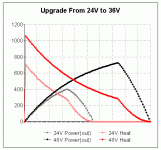andrey320
1 W
Hello!
I ride a 2006 Izip Cruiser Enlightened. This is my original thread - http://endless-sphere.com/forums/viewtopic.php?t=270&highlight=
I will be moving in two weeks which will increase my commute to nine miles each way and add a fairly long and steep hill. At the moment, my bike does great going 15 miles/hour on flat roads. The controller overheats on hot days and on continuous uphills. After reading this thread – http://endless-sphere.com/forums/viewtopic.php?t=238&highlight=
and looking at the motor’s manufacturer’s website, I realized that there is a 36 volt version of the motor. This may open the opportunity of upgrading my bike!
Here are the specs of my bike -
Battery - NiMH EV Rated Batteries- Down Tube Concealed-24V / 9AH Pack - (20) 1.2V Rechargeable Cells
Motor - Exclusive Alloy Shell DC Brushless Geared Hub Motor (by Tongxin)
Controller - Exclusive Currie Electro Drive - 24 Volt Fully Potted (the sticker says – 300W, 24V, 15A
My goal for upgrading would be to increase top speed to 20-25 mph, and increase range to 30-40 miles. Current range is 20-25 miles(maybe longer - I've only gone 20 miles max).
Is this possible? What would be involved in this project? I am not very good with electronics, by am mechanically inclined and can follow directions. I guess the new motor, more batteries, new controller, and different gearing is what will need… don’t know the details though. Where to get the motor / controller / batteries (and what kind)? How to do the wiring? Would it be easier to build a new bike?
Here is some wiring and other tech info - http://www.tongxin.net.cn/en/download.htm
Here is a website where I can inquire about the tongxin products - http://product.globalimporter.net/china-sample/59965/Hangzhou+Zheda+Tongxin+Electric+Technology+Co,.+Ltd./1.htm
Thanks for reading and for any useful information you may provide!
Andrey
I ride a 2006 Izip Cruiser Enlightened. This is my original thread - http://endless-sphere.com/forums/viewtopic.php?t=270&highlight=
I will be moving in two weeks which will increase my commute to nine miles each way and add a fairly long and steep hill. At the moment, my bike does great going 15 miles/hour on flat roads. The controller overheats on hot days and on continuous uphills. After reading this thread – http://endless-sphere.com/forums/viewtopic.php?t=238&highlight=
and looking at the motor’s manufacturer’s website, I realized that there is a 36 volt version of the motor. This may open the opportunity of upgrading my bike!
Here are the specs of my bike -
Battery - NiMH EV Rated Batteries- Down Tube Concealed-24V / 9AH Pack - (20) 1.2V Rechargeable Cells
Motor - Exclusive Alloy Shell DC Brushless Geared Hub Motor (by Tongxin)
Controller - Exclusive Currie Electro Drive - 24 Volt Fully Potted (the sticker says – 300W, 24V, 15A
My goal for upgrading would be to increase top speed to 20-25 mph, and increase range to 30-40 miles. Current range is 20-25 miles(maybe longer - I've only gone 20 miles max).
Is this possible? What would be involved in this project? I am not very good with electronics, by am mechanically inclined and can follow directions. I guess the new motor, more batteries, new controller, and different gearing is what will need… don’t know the details though. Where to get the motor / controller / batteries (and what kind)? How to do the wiring? Would it be easier to build a new bike?
Here is some wiring and other tech info - http://www.tongxin.net.cn/en/download.htm
Here is a website where I can inquire about the tongxin products - http://product.globalimporter.net/china-sample/59965/Hangzhou+Zheda+Tongxin+Electric+Technology+Co,.+Ltd./1.htm
Thanks for reading and for any useful information you may provide!
Andrey







